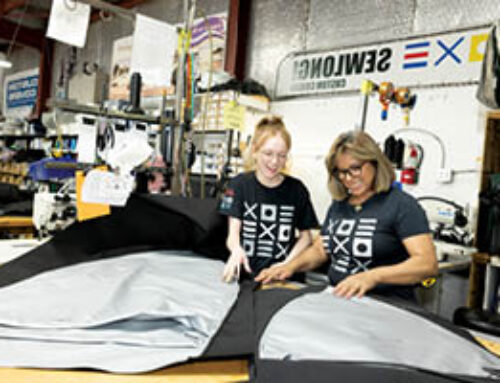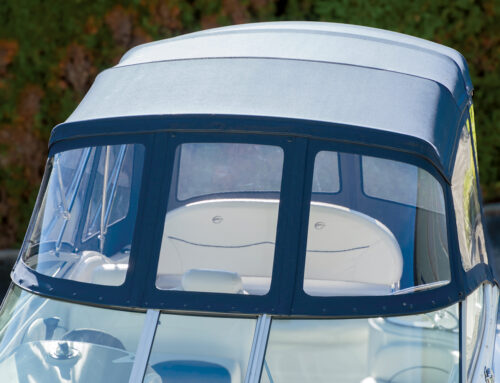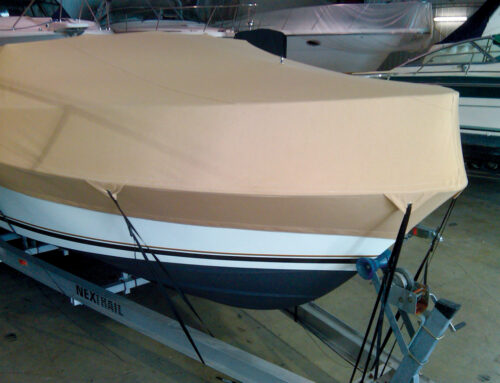Building a dream shop
Your new, ‘ideal’ shop should not fit your needs like a glove.
By Gary Legwold
Two things you should know about the ideal canvas shop:
1. It’s a myth.
2. Shop owners are into mythology.
The ideal shop is a myth for all but a small minority of marine fabricators because no matter how many times they move to a more ideal shop, it rarely ends up being ideal enough. At best, “the ideal shop is a moving target,” says Mike Erickson, MFC, of Canvas Designers Inc., in Riviera Beach, Fla.
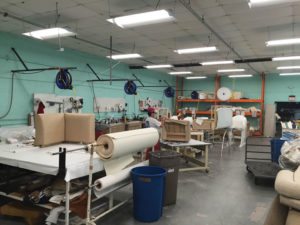
At Canvas Designers Inc., Mike Erickson has specific tables for specific jobs, thus increasing efficiencies.
Even with a 35,000-square-foot space, Erickson’s shop wasn’t close to ideal after moving in. “We’ve had to completely rearrange things five times in the last three years,” he says. “The original intention was to rent two bays, but we need one now and we’ll probably need the other soon. We may even have to add on.”
The shop finds you
For most marine fabricators, it’s traditionally less a matter of finding or creating the ideal shop space and more a matter of that space finding them…eventually. They are like Mike Johnson of Mike’s Marine Custom Canvas in Virginia Beach, Va., who started his business in a garage by charging half the going rate. He increased his rates and got busier (funny how that works), and soon outgrew a 700-square-foot space.
“We’re like a mom-and-pop shop on steroids,” says Johnson, who employs two full-time seamstresses. He has settled into his current 1,120-square-foot (16 by 70 feet) shop, which is good but not ideal. “I need it 10 feet wider for a second table, to handle extra-wide bimini tops and such,” he says.
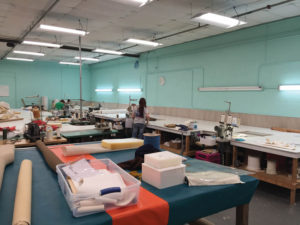
In his quest for an “ideal” workspace, Mike Erickson of Canvas Designers Inc. in Riviera Beach, Fla., has had to rearrange his 35,000-square-foot shop layout five times in the past three years. And he says he might have to add space in the future.
Larry Schneider of Homestyle Awning & Upholstery in Bay View, Wis., started in his basement and then, in 1983, converted a gas station in Oak Creek, Wis., into a shop. He and five employees worked there for 24 years, “tripping over each other because the business was bursting at the seams,” he says. “I would have never moved, but the property was sold for development and the gas station torn down. I moved to my current location [2,000 square feet] only because the building was blighted and cheap, and I was going for cheap.”
Going for cheap: Yes and no
While it’s clear that finding or creating the ideal shop—at least right out of the chute—is a myth, it is also true that the quest for such a space is worthwhile. It might save your business.
“Thinking too small is probably the biggest challenge of a canvas shop owner,” Erickson says. “You want to keep costs down and figure what you minimally need, but looking at the big picture, sometimes that shortsightedness about what you’re going to evolve into ends up costing you more than if you had gone with a little bit more space to begin with.”
Certainly, you have to watch costs at all times, Erickson says, but not so closely that you become myopic. Pulling a plastic-fabrication job off the same table that’s used for sewing is a drag on your efficiency and therefore the health of your business. While scrambling to finish jobs in cramped corners is seemingly a rite of passage for canvas shop owners, it’s not the way to survive and thrive. “Too many people get into this business for the project but not really for the profession,” he says. “There’s no code or national standards, as with plumbing, and people are too often artistic-oriented; their business is not really based on price, but on quality. They are artists, but the only artist I ever knew who got rich was a dead one.”
Architect Douglas Kozel puts it this way: “Is this about production, or is this about craft?” Kozel is a partner at KEE Architecture in Madison, Wis. He says many canvas-shop owners believe it’s about craft; they are the “artists” that Erickson described. They don’t necessarily want to get into management (hiring, firing, sales calls, purchasing) and never get out of the front office. “They probably want to know about each piece that moves through the shop,” says Kozel.
Mitten or glove?
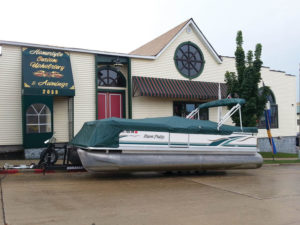
Larry Schneider of Homestyle Awning & Upholstery in Bay View, Wis., started in his basement and then moved into a converted gas station that was later torn down. His current location features 2,000 square feet and his office just off the workspace.
Knowing who you are as a shop owner is a must in creating the ideal shop. Erickson is still hands-on with key clients, but he’s into management. Schneider is not. “I’m not that organized as far as business structure,” he says. “I’m OK with being pretty much a one-man show who needs a lot of help. Sometimes I think I’d like to check out more expansion, but I’m 58 and looking to retire at 65. I don’t know if I want to take on something like that.”
You may not be sure what the future holds if you stay small or grow big, which is not uncommon. “We design a lot of buildings, and when we ask clients to see growth in three, five and 10 years, they think they will peak after five years, that growth will be flat,” says Kozel. “It’s almost a human trait that people cannot see beyond five years.”
Given that fuzzy future beyond five years, Kozel advises thinking mitten and not glove when searching for your ideal shop. He says most buildings are torn down not because they are worn out but because they become obsolete. “Loose fit [mitten] equals long life,” he says. “There are many ways you can occupy a space, but if you over-particularize what you put in that space right away [glove], then those things that seem wonderful often end up not working out at some point. You want to plan in a tolerance that gives you flexibility rather than locking down everything explicitly. You want a workplace you can adapt through time as needs change and as your point of view changes with learning.”
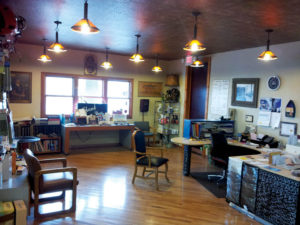
Larry Schneider of Homestyle Awning & Upholstery in Bay View, Wis., started in his basement and then moved into a converted gas station that was later torn down. His current location features 2,000 square feet and his office just off the workspace.
Three little words
Much is made in business about location, location, location. So should you limit your search for the ideal shop to an ideal location near a marina? Johnson’s shop is within two blocks of three marinas, which is important because “80 percent of what we do is work on smaller fishing and pleasure boats,” he says. “But this is a tourist town with waterfront property, so the rent is higher than at a lot of other places. In general, I would probably take the ideal space over the ideal location. The time
you spend in the shop outweighs your travel time.”
Schneider agrees. “Location, I never worried about,” he says. “Overhead cost
is important, and if you have to drive a little farther but pay half the rent, that’s OK. Having done this for 40 years, it seems that word of mouth is working
out pretty well.”
Gary Legwold is a freelance writer from Minneapolis, Minn.
A Green shop?
Canvas-shop owners recycle scraps of fabric and plastic when they can, but they all lament that recycling is not always an efficient process. “Recycling is about ease of use, and we need more proactive programs,” says Mike Erickson.
In his Canvas Designers Inc., shop in Riviera Beach, Fla., Erickson did replace fluorescent lighting with LED lights, which are environmentally friendlier. Beyond that, about the best way to go green is to find a shop in a green building made of green materials.
“Go into an existing building—that alone helps the environment,” says Douglas Kozel, a partner at KEE Architecture in Madison, Wis. “A green building conserves energy, has a small carbon footprint, is made of low-toxic materials—paints with no VOCs, glues and sealants that are healthy for the environment, that sort of thing. A green building also has landscaping that includes native species that reduce the need for excess watering. A green building is close to public transportation so that you don’t have to drive to work, to haircuts, to lunch.”
 TEXTILES.ORG
TEXTILES.ORG 


